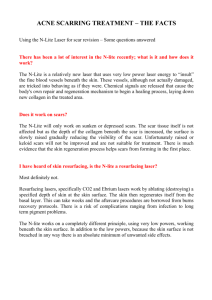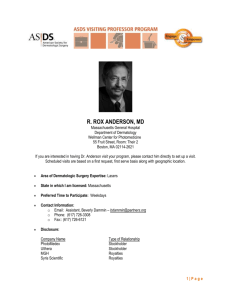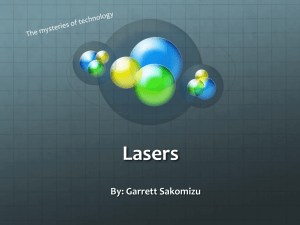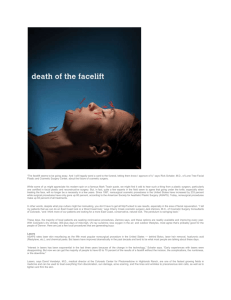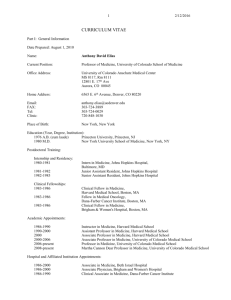File
advertisement
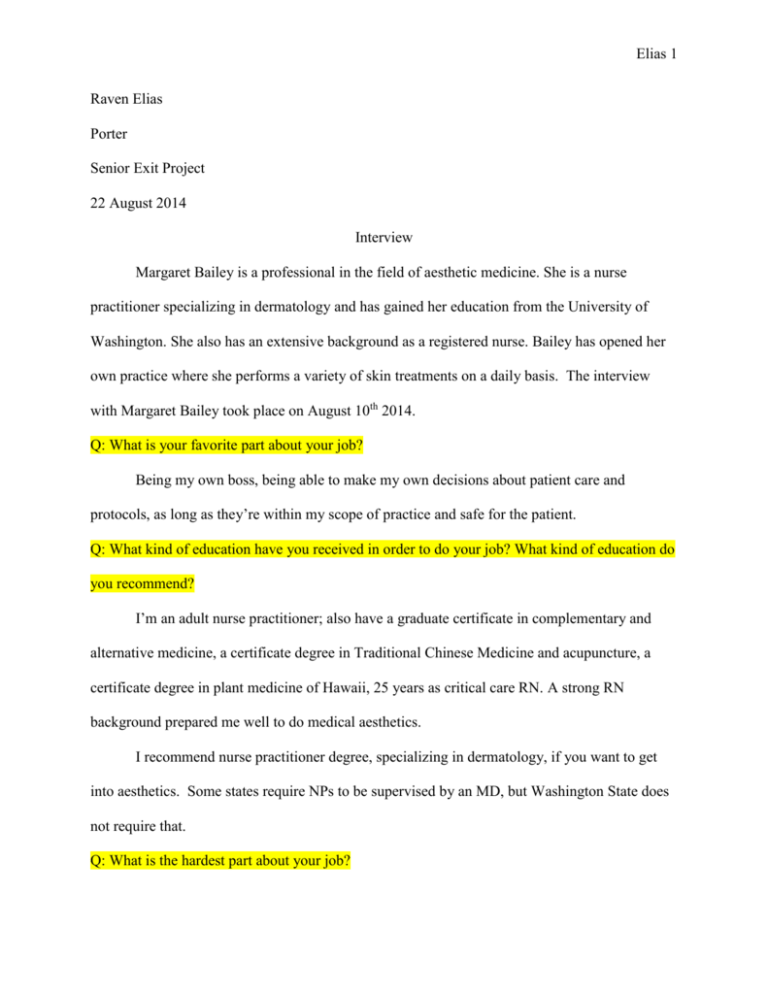
Elias 1 Raven Elias Porter Senior Exit Project 22 August 2014 Interview Margaret Bailey is a professional in the field of aesthetic medicine. She is a nurse practitioner specializing in dermatology and has gained her education from the University of Washington. She also has an extensive background as a registered nurse. Bailey has opened her own practice where she performs a variety of skin treatments on a daily basis. The interview with Margaret Bailey took place on August 10th 2014. Q: What is your favorite part about your job? Being my own boss, being able to make my own decisions about patient care and protocols, as long as they’re within my scope of practice and safe for the patient. Q: What kind of education have you received in order to do your job? What kind of education do you recommend? I’m an adult nurse practitioner; also have a graduate certificate in complementary and alternative medicine, a certificate degree in Traditional Chinese Medicine and acupuncture, a certificate degree in plant medicine of Hawaii, 25 years as critical care RN. A strong RN background prepared me well to do medical aesthetics. I recommend nurse practitioner degree, specializing in dermatology, if you want to get into aesthetics. Some states require NPs to be supervised by an MD, but Washington State does not require that. Q: What is the hardest part about your job? Elias 2 Keeping up with the paperwork and bookkeeping. Q: What is the interaction like between you and your patients? What is it like having a job that requires so much communication and interaction? RN training includes much training on therapeutic communication, and so prepares practitioners to communicate in a professional manner with patients. I consider it an honor and a privilege to care for patients. Q: How much information did you gather before purchasing your lasers? How many lasers do you recommend having in an office and which ones? I took a laser repair technician course, and two aesthetic laser operator courses, and these taught me some basis about machines. For example a pulse dye IPL is an expensive machine to maintain, and the dye packs need replacement often, and is tricky. I’d recommend one platform (I bought Alma Harmony XL) and you can add different hand pieces to it as you go along. I also recommend a great ultrasound fat cavitation machine (I have a Med Sculpt from General Project out of Italy). Q: Are there other machines besides lasers that you recommend having in an office? I like radio frequency treatments, and ultrasound fat reduction, also microdermabrasion. I would recommend buying machines that don’t require expensive consumables. Check out MedicalSpaMD.com for discussions on technology. Also check out machines individually on YouTube. I really like Ulthera. Q: What is your favorite procedure to do on patients and why? iPixel or 360IQ. This is an Alma Harmony XL procedure that transforms the patient’s skin very quickly, in under a week, with only mild sunburn, and about 3 days of downtime. Elias 3 Q: What procedure is requested most by your patients? Why do you think this is? Body contouring, probably due to the American diet. Q: What was the process of opening your own office like? How long did it take and how difficult was it? It was a long process because I had to obtain the proper education in order to operate the lasers and go through the process of buying my own equipment. Q: What advice would you give to someone who is opening their own office? Learn the laws, federal, state, county, and city, and make sure you have a way to keep up with all of them. Q: How safe are the lasers on skin? That all depends on the knowledge and experience of the operator. I like to take a more cautious approach, having patients back multiple times for smaller treatments, because sometimes plowing through a dermatologic problem in one or two treatments can result in patient harm, like hypopigmentation or hyperpigmentation, or even scarring. Q: Have you ever had a patient react negatively to a treatment, if so why? If not, have you ever seen a patient react negatively to a treatment you did not perform? Once a patient had a little redness on the right side of her neck after an infrared treatment for “turkey neck”, but I quickly applied an ice pack to prevent the spread of thermal damage. I used the same principle as putting your hand in cold water after a burn to stop the burn from spreading, and it worked. Once I attended a conference where a patient was treated very aggressively and very quickly, with CO2 laser, invasive liposuction under the chin, Juvaderm, Radiesse, and many Elias 4 units of Botox. That patient had a stroke with right-sided facial droop. I think it’s always better to be on the side of caution. Q: How can the lasers benefit an individual's appearance? Lasers can tighten sagging skin, make color corrections to birthmarks (port wine stain), remove wrinkles, clear up acne, remove psoriasis, remove spider veins, warts, freckles, redness from rosacea, and lasers can improve many other skin conditions (see attached chart). Q: What is the typical patient's reaction in regards to their appearance before and after a treatment? The hardest thing for patients to understand is that they will not see the full results at the end of a laser treatment. If they are really heavy, and I’m working on reducing the sagging skin under their chin, they might not see the results until the 2nd or 3rd treatment. Once they start seeing the results, they are usually very happy. However, many do see results on the first treatment. In any case, I am usually remodeling the skin under the epidermis, so results continue to increase for several months to come. Q: How does an improved appearance benefit the life of the individual? In terms of social life, mental health, and dating life. Sometimes when a person perceives they are defective in appearance, they will have some hopelessness or depression along with the problem. Usually there is an increase in hope, a decrease in depression, and a renewed commitment to taking better care of themselves. I treated my sister, a commercial plumber, with ultrasound fat cavitation and she was able to buy smaller clothes, even a red string bikini, and she told me that her co-workers are flirting with her now. Q: Does the patient's personality often change as their appearance changes? Do they show more self-confidence? Elias 5 Yes. You can go on RealSelf.com and read actual patient experiences and see how they rate the treatments. Again, results depend on the skill and artistry of the laser operator. You can also go on MedicalSpaMD.com and register, and then read what the doctors are saying about giving treatments, and also how they rate equipment, plus other discussions. Q: Do you think the act of a person altering their appearance is out of vain? My grandfather was born with a cleft palate, so no, I don’t think people should have to live with things like that, or even acne. I went through my teenage years with acne, and it was awful. I wish someone could have waved the magic laser and helped me through it; instead, I suffered from shyness. I believe technology is an amazing gift in the right hands, and can provide well-being to many who are sad about certain conditions that they were born with, or acquired conditions. Stretch marks after birth is another example, and even though some scars should be worn with pride, many women are happy to be recipients of technology that heals striae and/or melasma. Q: In what case(s) would you refuse service to a customer? Body dysmorphic disorder, under the age of eighteen, diabetic, history of keloid scarring, drug-addicts, alcoholics, compromised immune system, delayed wound healing, brittle diabetes, or severe mental disorders such as schizophrenia. Q: What are your thoughts on Botox and plastic surgery? If you could, would you perform these types of procedures? I like to go by the Hippocratic Oath, “First, do no harm.” Therefore, I always choose the least invasive treatment first, like putting my foot on the lowest rung of the ladder first. I think injecting people with neurotoxins or subjecting them to general anesthesia for conditions that can Elias 6 be treated by lasers or ultrasound is not ethical, and it violates my interpretation of the Hippocratic Oath. Q: What type of people do you most commonly see coming in for laser treatments? Why do you think this is? Men only comprise 15% of aesthetic medicine procedures, so the answer is females come for laser treatment most commonly, from the ages of 35-55. Quite frequently the women are going through loss of a job, and returning to a job search, or loss of a marriage, and returning to dating. A little non-invasive tune-up helps them be more confident during these kinds of transitions. Often, the person will be getting ready for an event such as a wedding or a cruise to a tropical location.



